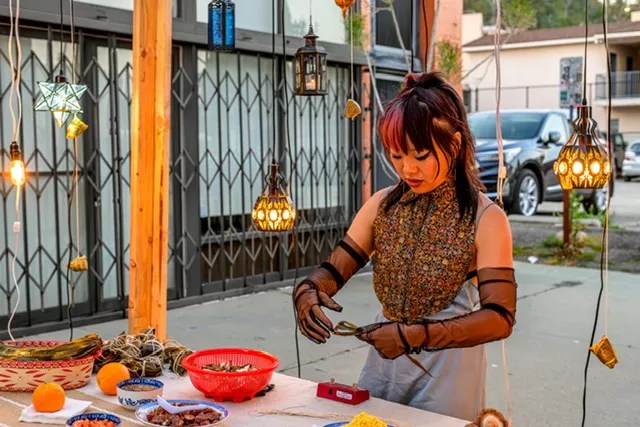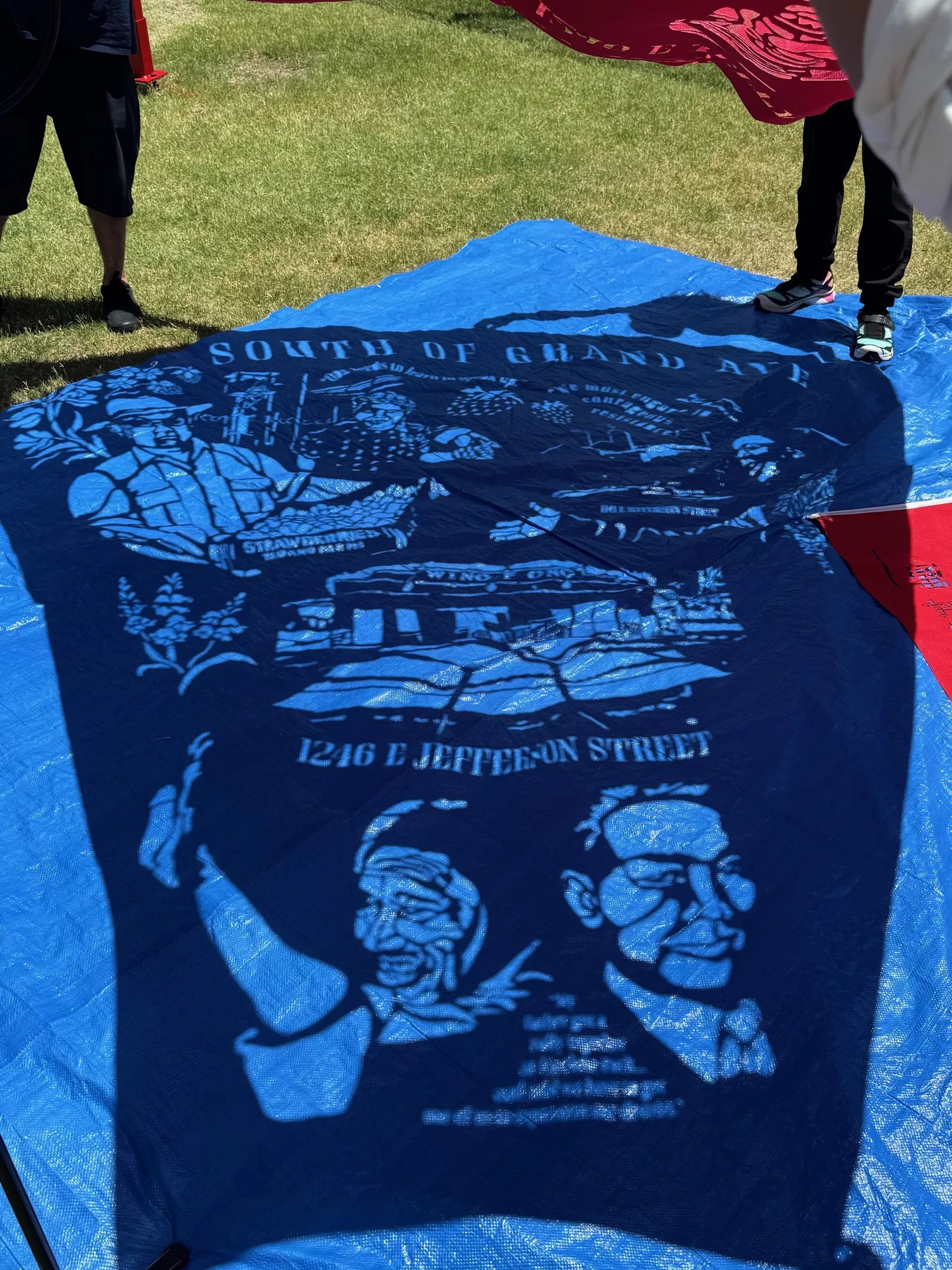
Feng-Feng Yeh

Audio By Carbonatix
Across cultures, food is a shared experience that brings people together. For artist Feng-Feng Yeh, food also became a portal through a Wild West historical journey and a creative quest to learn more about Chinese chorizo in Arizona.
Yeh, who grew up in Tucson, spent 20 years working in New York City and then found herself back in the desert during the pandemic. As she adjusted to life back in the desert, she became fascinated with uncovering the hidden history of Chinese communities in Arizona, and Chinese chorizo, a local delicacy that not only enabled immigrants to survive, but thrive and build community.
In the mid-to-late 1800s, Chinese immigrants in search of a better life came to Arizona as part of the Gold Rush, seeking railroad-building and mining opportunities. They faced tremendous prejudice and violence, including the Chinese Exclusion Act of 1882.
Yet, throughout Arizona, the Chinese community found ways to thrive. Chinese Chorizo, made from scraps of meat and revived with a blend of wine and spices, became an in-demand local delicacy. Chinese grocers often operated as community banks and spaces to congregate safely.
This year, make your gift count –
Invest in local news that matters.
Our work is funded by readers like you who make voluntary gifts because they value our work and want to see it continue. Make a contribution today to help us reach our $30,000 goal!

Feng-Feng Yeh makes Chinese chorizo.
Feng-Feng Yeh
Wanting to share this remarkable and delicious history with others, in 2022, Yeh received a grant to start the first-ever Chinese Chorizo Festival. In the past three years, the festival has grown to more than 75 restaurants and organizations across Arizona, over 2,100 pounds of sausage donated and Pima County naming October Chinese Chorizo Month.
On June 21, as part of the Phoenix Office of Arts and Culture’s “¡Sombra!” project, a public arts initiative to address climate change and urban heating, Yeh will unveil her design of a giant Chinese chorizo sculpture, which will include shade sails bearing stories of resilience, in Eastlake Park. The event, which will be held from 11 a.m. to 1 p.m., will include a special meet-the-artist experience with Feng-Feng Yeh; a culinary collaboration featuring dishes crafted with Chinese chorizo by Mrs. White’s Golden Rule Café; handcrafted drinks by Skoden Coffee created in collaboration with the Chinese Chorizo Project; live African drumming and dance from Kawambe-Omowale; and more.
Eastlake Park itself has a storied history as a landmark of the Civil Rights movement. Both Booker T. Washington and W.E.B. DuBois spoke at the park, and it was historically the starting point for all civil rights marches to the Capitol.
Yeh chose the site of Eastlake Park to show that Asian and Black communities have always existed together and supported one another. Yeh hopes her artwork, as well as the stories behind it, will encourage people to learn more about historically othered communities, who have created beautiful art, food, music and culture in the face of oppression.
Phoenix New Times spoke with Feng-Feng Yeh about how a night of doom scrolling led her to learn about the fascinating history of Chinese immigration in Arizona, the food lore of Chinese chorizo and how it all exploded into one big delicious festival, a sausage sculpture in a Phoenix public park and a community history brought to light.
Phoenix New Times: What was your personal story finding out about Chinese Chorizo?
Feng-Feng Yeh: I’m from Tucson; I grew up here. I left Tucson to pursue fashion design in New York in 2002, and lived there for 20 years. I was in New York nightlife for a while and used to throw parties. I was working in luxury fashion, and toward the end, I felt like I was plateauing and not growing.
Was cooking and food always something you were passionate about?
I was always inspired by my mom’s cooking, so I always felt it was so powerful and such a love language. After working in stores and fashion I really felt I needed a creative outlet, so I started doing a thing called Chow Downtown. It was kind of a wellness brand I was trying to pivot from the likes of Goop, which is such a white-woman vibe. I was like, what does the queer person of color wellness space look like?
I wasn’t great at food back then, but I was learning. I would invite my friends who were up-and-coming chefs. Then the pandemic really took its toll. I started feeling like I should go home to my parents in Tucson. So I’m in Tucson wondering, what the hell am I doing with my life? I was doomscrolling late at night and found a grant from the Andy Warhol Foundation, which was calling for a community-driven project. I wanted to do it, but I felt like I didn’t have any community in Tucson (because) I hadn’t lived there in 20 years.
I started reflecting on my childhood rooted in Tucson, and I always felt really alienated. I was one of the only Asians in my school; now, the world has changed so much. I started researching the history of Chinese people here. I went on the Tucson Chinese Cultural website and found a story of these Chinese grocers and a video talking about Chinese chorizo. How this food was not only a fusion food, but a symbol for this community developing bonds and resilience. It was a sausage made out of scraps – something that might be destined for the trash, but it was utilized and revived with this delicious red wine, Mexican spices and chilis, and turned into something highly desirable.
As Arizona changes, communities here are becoming more seen. What is the importance of telling those stories and histories outside of white narratives here in Arizona?
That is a really important part of uplifting this history. Growing up, I never heard of this huge amount of Chinese grocery stores that thrived in Tucson. By 1950, there were 114 Chinese grocery stores that existed at once, so this was really the lifeline of the community. I’m finding in my research (that) it was the same in Phoenix.
In the Eastlake Park community, there were a number of Chinese grocers and restaurants that provided credit for the community as well as a safe space for people. They would act as banks for people. It’s fascinating how the discrimination they faced actually brought people together. These Chinese grocers were prohibited from purchasing their own homes, they were segregated and red-lined. So many had to live behind their own grocery stores in order to survive.
So the Chinese population in Arizona what were some of the reasons they originally came here?
Yeah, there were a few reasons. Chinese people began really coming to the United States in the mid-to-late 1800s. In Southern China at the time, there was a huge flood and there was some political unrest, forcing people to seek better lives. Because of the Gold Rush and westward expansion, there were a lot of jobs available to build railroads and mining opportunities. So they were doing a lot of jobs that were low-wage, that a lot of Anglos did not want to do.
When you look back at the history, it’s the same narrative, where white people were saying, “They’re taking our jobs.” But they were jobs no one wanted to do. So, this was really about padding for the end of slavery, they switched from the Black population to the Chinese.
And instead of an outright physical enslavement, it becomes a financial enslavement.
Exactly. So from this humble history of the Chinese chorizo, I found out all this United States history which I had never really learned and which is so relevant today. The Chinese Exclusion Act of 1882 was kind of the watershed for immigration policy today. On the U.S. Border Patrol website, they still talk about how the beginning part of the act was targeted to catch Chinese people from traversing the borders.
So how did all this research then become an art project and a sculpture?
I initially proposed to do a Chinese Chorizo Festival as a kind of prelude to the giant sausage sculpture. We did a small festival that first year in 2022, and I made 600 pounds of Chinese chorizo and donated it to maybe 20 restaurants. Fast forward to the past three years, it’s grown to over 75 restaurants and organizations across Arizona, and over 2,100 pounds of sausage donated, so they can use it to tell the history in a new way through food. … I traditionally don’t have it at a festival site; you have to go to different restaurants, sort of like a pub crawl. In Pima County, the month of October is now claimed Chinese Chorizo Month, so that’s when this happens. So it’s progressed into a bigger cultural activation.

Cutouts on the shade sails project stories of the community.
City of Phoenix
How did the sculpture in Eastlake Park happen?
I had told one of my best friends from growing up here what I was doing, and she just started crying. She was like, “Oh my God, my ‘uncle,’ he is an elder, part Chinese and part Mexican, is the founder of the AZ Asian Chamber, and he used to make Chinese chorizo.” He is based in Phoenix and has been an activist for Asian rights for years. His wife is Marian Tadano, who is a Japanese internment camp survivor. I got connected with them and was learning even more history.
When I saw “¡Sombra!” which is a public art shade project, I thought wow, red-lined districts are also disproportionately impacted by climate change. Those areas were labeled in the red-lining as hazardous and undesirable.
I also picked Eastlake because it is a historic park for civil rights. It’s a place where Booker T. Washington and W.E.B. DuBois spoke, where people organized and a real hub and center for the Black community. That is super meaningful to me because often, Asian and Black communities are pitted against each other, and this sculpture tells the story of how we have existed together and have supported one another in the community.
The shade sails suspended from the chorizo sculpture will include stories of resilience from people in the community inspired by Chinese shadow puppets. So the stories will be cut out on shade sails, and when the light passes through, they will be projected as shadows on the sculpture and park.
You’re using art and food, which both have rich cultural memory histories, to open a door for people to learn more about their city. What did you learn from your journey?
This sculpture, my thesis for it is that human relations are the foundation of us figuring out these human crises. Community is the thing that can help us move through issues that really impact all of us. Just because something is labeled one way, it doesn’t mean it is that way. I hope it inspires people to explore their place, their roots and each other. There is so much to celebrate in each other’s humanity and to be more curious about.